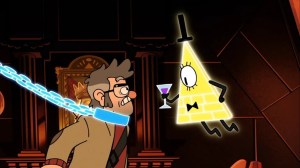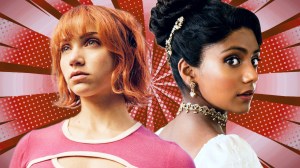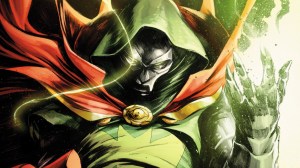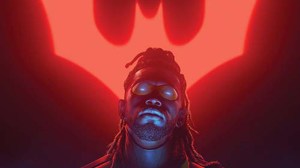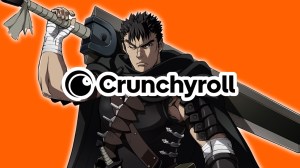In comics, one thing is certain: “the end” is never The End. Marvel is looking to upend (no pun intended) that dynamic with a series of one-shots titled The End, in which their iconic characters face the definitive, and final, threat of their long superheroing careers. In the case of Captain America: The End — from legendary Spider-Man artist and Savage Dragon creator Erik Larsen — the tale pits the super-soldier up against the Red Skull in what the solicitation text refers to as the final challenge for “Simon and Kirby’s” character. That’s especially apt here, as Captain America is versatile and malleable, but maybe the most impactful take on the character is the original, shaped by the rise of fascism in Europe and the second World War.
Videos by ComicBook.com
That is the plan Larsen brought into battle: tell the story — the biggest, and final, Captain America story. And tell it the way Joe Simon and Jack Kirby would, if they were still alive and so inclined.
Larsen joined ComicBook.com to share some looks at the interior art as well as his thoughts on the one-shot, which will be in stores next month.
Month in and month out, you work on a book and a character that will probably never end as long as you’re in comics. Is it a big change of headspace to do “The End?”
Well, sure and both have huge challenges. With Cap I’m trying to “stick the landing” and have it be a sold final mission while on Savage Dragon there’s never a real ending, there’s always another day — a next issue. They’re two very different kinds of disciplines. And there are aspects of each that are harder and easier. With an ongoing book you never get that satisfying conclusion because it has to continue. So even when you feel like an issue really brings a story to a satisfying conclusion—that can never really happen but there’s an aspect of that which makes it easier too — you can keep kicking bits and pieces down the road. While, with something like this, ideally, you don’t want to leave it open. You want it to feel like a real ending — a grand finale.

Obviously you’re a big Kirby guy and have even used one of his Cap layouts for a cover in the past. Was that part of the appeal of this project?
I’m a huge Kirby fan and it’s just fun to play with his toys. I was always more of a Jack Kirby guy than a Steve Ditko guy and yet I found myself on Ditko’s most successful title and for many readers—that’s how they see me but I’m far more comfortable in Jack’s shoes than Steve’s and it’s an opportunity to exercise more of those muscles. Finally! I’ve been able to dabble a bit with Jack’s characters in the past, I drew four issues of Thor (the first Marvel comic book I ever drew was Thor #385, which featured a Hulk Vs. Thor story that ended up being scripted by Stan Lee and inked by Vinnie Colletta — so I was literally subbing for Jack in that classic creative team! And it was the last issue either of those two ever worked on, which was a helluva way to kick off my career). I also drew (and later wrote)–an issue of the Hulk and was one of the masterminds behind the epic Fantastic Four: The World’s Greatest Comic Magazine maxi series. But this is my first ever Captain America story! After being in the biz nearly 40 years, it’s nice to know that there are still a few mountains left to climb!
When you’re writing “The End,” is there any other choice besides Red Skull for the villain?
There’ll be a few other surprises in the mix but the Red Skull really is Cap’s arch nemesis. To end with the Armadillo, Flag-Smasher or the Tumbler would be pretty anticlimactic.

Is there a simple distillation of what your version of Red Skull kind of “stands for” in opposition to what Cap means?
It’s not a traditional Red Skull story. Essentially his toxin has mutated into a virus and everybody becomes the Red Skull. The whole world is out to kill Captain America and he becomes the last man standing—humanity’s last hope.
On that note, Captain America is, more than almost any other comic book character, a symbol as much as he is a character. How do you apply that to this dystopian world where the thing his symbol stands for is basically gone?
Captain America has always stood for the American dream—not necessarily the American reality. He’s what we all strive to be. He’s an ideal. He’s what we wish we were and as such, he fights to preserve, protect and restore America and democracy the world over. He’s a freedom fighter and as long as there’s a dream to fight for — he’ll fight that battle. But he’s more than simply a symbol—he’s a man—and that aspect is a huge part of his appeal.
Are there any other Marvel characters fans can expect to see in the story?
This is really Cap’s story and I didn’t want to clog it with guest stars or show the fates of other Marvel characters. It’s very focused.
Working on a character as bigger-than-life as Captain America, do you have to try and crack the code on “your take?”
I didn’t really want to do “my take”. I wanted to do Jack’s take. The classic take. I’m not doing a hard Jack Kirby homage here but I wanted it to feel like it was a continuation of that. I wanted it to feel like a classic Cap tale and not make him my own. I think in some ways we can do a disservice to these characters by straying too far off model. If I was drawing a caricature of a real person and another artist was doing the same, it might look pretty different but you could tell we were both trying to draw the same person. This is very much that. I’m looking at Kirby’s Captain America and attempting to draw that man as though he was a real person and Jack nailed his likeness.

How do you think this Captain America story is fundamentally different to one that Jack and Joe could have told in their time?
The state of the art has changed. The coloring, printing and lettering were never that crisp and beautiful. So there’s an obvious dissimilarity in that regard but also we all think differently. Our approaches aren’t the same and as much as I might try to be part of their world—I can’t be. At the same time, I bring things to the table that neither of them would have done. It can’t help but be different because I’m a different person with a different approach and a different style and a different sensibility.
Captain America: The End #1 will be available in comic shops and online on January 29. The final order cutoff date for the issue is Monday, January 6.



